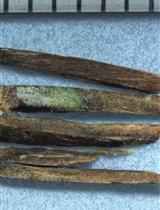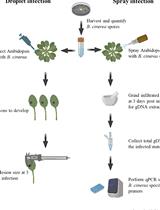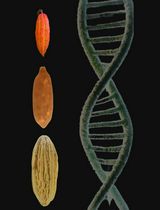- EN - English
- CN - 中文
Rolling Circle Amplification to Screen Yam Germplasm for Badnavirus Infections and to Amplify and Characterise Novel Badnavirus Genomes
滚换扩增筛选山药Badnavirus感染种质并扩增鉴定新型Badnavirus基因组
发布: 2018年01月05日第8卷第1期 DOI: 10.21769/BioProtoc.2672 浏览次数: 10221
评审: Modesto Redrejo-RodriguezAnonymous reviewer(s)
Abstract
Since the first discovery of badnaviruses (family Caulimoviridae, genus Badnavirus) in yam (Dioscorea spp.) germplasm in the 1970s (Harrison and Roberts, 1973), several hundred partial badnavirus reverse transcriptase (RT)-ribonuclease H (RNaseH) sequences have been characterised (Kenyon et al., 2008; Bousalem et al., 2009), but only a few complete Dioscorea bacilliform virus (DBV) genome sequences have been reported (Phillips et al., 1999; Seal and Muller, 2007; Bömer et al., 2016 and 2017; Sukal et al., 2017; Umber et al., 2017). We have optimised a workflow involving total nucleic acid extractions and rolling circle amplification (RCA) combined with restriction enzyme analysis for the detection and amplification of DBVs present in yam germplasm. We have employed this approach successfully revealing three novel episomal yam badnaviruses (Bömer et al., 2016). We proposed this to be a complementary method to denaturing gradient gel electrophoresis, which enables a rapid indication of badnavirus diversity as well as the identification of potentially integrated badnavirus sequences in the host genome (Turaki et al., 2017). Here, we describe the step-by-step protocol to screen yam germplasm for badnavirus infections using RCA as an efficient research tool in the amplification and characterization of novel badnavirus genomes.
Keywords: Yam (山药)Background
RCA is a sequence-independent strategy regularly used for the amplification of circular DNA virus genomes (Rector et al., 2004). Phi29 polymerase-mediated RCA techniques for (i) the detection of novel viruses; (ii) whole genome analysis of viruses; (iii) the generation of infectious clones; (iv) virus diagnostics of known viruses; (v) identification of replicative forms of viral genomes and; (vi) the differentiation between linear and circular forms are important tools in virology (reviewed by Johne et al., 2009). Circular target sequences are amplified more efficiently in RCA reactions as compared to linear templates. RCA has been recognized as a method of choice for the detection of Banana streak virus, also enabling the discrimination between integrated and episomal virus sequences (James et al., 2011) and was proposed to be used for DBV diagnostic purposes in yam (Umber et al., 2014). We uncovered several limitations to the usefulness of RCA in DBV diagnostics discussed in our previous study, including the amplification of putatively integrated sequences at lower frequencies and the amplification of circular plant plastid sequences. A relatively high chance for false-negative results also exists due to potential inhibition of the RCA assay due to plant compounds present in yam DNA extractions. We concluded that RCA is a useful tool for DBV research purposes (Figure 1, Bömer et al., 2016), which has been demonstrated several times since then (Bömer et al., 2017; Sukal et al., 2017). This led to the amplification and characterisation of several new full-length yam badnavirus genomes.
Figure 1. Scheme of the rolling circle amplification (RCA) method described in this protocol for the selective detection of episomal badnavirus genomes. RCA is a sequence-independent multiply-primed technique which can be used for the amplification and characterisation of episomal badnavirus sequences and was evaluated in yam germplasm in a previous study (Bömer et al., 2016).
Materials and Reagents
Note: The protocol described here is based on the successful RCA of three yam badnaviruses (Bömer et al., 2016).
- Consumables
- Gauge bags for sampling and grinding (10 x 15 cm) (Polybags, catalog number: 46500 )
- 1.5 ml microcentrifuge tubes (Alpha Laboratories, catalog number: LW2375 )
- 200 µl PCR tubes (Thermo Fisher Scientific, Thermo ScientificTM, catalog number: AB0266 )
- Pipette tips
- Petri dishes, round, 9 x 1.6 cm (Alpha Laboratories, catalog number: RC2260 )
- Polyvinylpyrrolidone (PVP) (MW 40 kDa) (Sigma-Aldrich, catalog number: PVP40T )
- QIAGEN Genomic-tip 20 G or 100 G columns (QIAGEN, catalog number: 10223 or 10243 )
- Plant material
Yam plants (e.g., Dioscorea rotundata and D. alata breeding lines and landraces maintained at the International Institute of Tropical Agriculture (IITA), Ibadan, Nigeria). Accession numbers are provided in the legends of Figures 4 and 5 - Competent cells and plasmids
- Reagents
- Deionized water (sterile)
- Nuclease-free, sterile deionized distilled water, e.g., HyCloneTM Water, Molecular Biology Grade (GE Healthcare, HyCloneTM, catalog number: SH30538.02 )
- Cloning
- Oligonucleotides (5’-3’), 10 µM
- Badna-FP_ATGCCITTYGGIITIAARAAYGCICC
- Badna-RP_CCAYTTRCAIACISCICCCCAICC
- M13F_TGTAAAACGACGGCCAGT
- M13R_CAGGAAACAGCTATGACC
- SP6_ATTTAGGTGACACTATAG
- T7F_TAATACGACTCACTATAGGG
- Badna-FP_ATGCCITTYGGIITIAARAAYGCICC
- Enzymes and buffers
Badna-PCR and colony-PCR- DreamTaq Green DNA polymerase (Thermo Fisher Scientific, Thermo ScientificTM, catalog number: EP0713 )
- 10x DreamTaq Green buffer (Thermo Fisher Scientific, Thermo ScientificTM, supplied with the enzyme)
- dNTP set (Thermo Fisher Scientific, Thermo ScientificTM, catalog number: R0182 )
- Agarose (Bioline, catalog number: BIO-41025 )
- SYBRTM SafeTM DNA gel stain (Thermo Fisher Scientific, InvitrogenTM, catalog number: S33102 )
- DNA-loading dye, e.g., 6x gel loading dye, purple (New England Biolabs, catalog number: B7024 )
- DNA-size standard, e.g., GeneRulerTM 1 kb Plus DNA ladder (Thermo Fisher Scientific, Thermo ScientificTM, catalog number: SM1331 )
- Tris-Borate-EDTA (TBE) buffer (Sigma-Aldrich, catalog number: T4415 )
RCA
IllustraTM TempliPhi 100 Amplification Kit (Amersham Biosciences, catalog number: 25640010 )
Restriction enzyme digestion- HindIII (New England Biolabs, catalog number: R0104S )
- NEBufferTM 2.1 (New England Biolabs, catalog number: B7202S , supplied with the HindIII enzyme)
- PstI (New England Biolabs, catalog number: R0140S )
- NEBufferTM 3.1 (New England Biolabs, catalog number: B7203S , supplied with the PstI enzyme)
Ligation - DreamTaq Green DNA polymerase (Thermo Fisher Scientific, Thermo ScientificTM, catalog number: EP0713 )
- Antibiotics and blue:white selection of transformants
- Ampicillin (Sigma-Aldrich, catalog number: A9518 , stock 50 mg/ml in deionized water, filter sterilized)
- Isopropyl β-D-1-thiogalactopyranoside (IPTG) (Sigma-Aldrich, catalog number: I6758 , stock 0.1 M in deionized water, filter sterilized)
- X-Gal (5-Bromo-4-chloro-3-indolyl-β-D-galactopyranoside) (Sigma-Aldrich, catalog number: B9146 , stock 50 mg/ml in dimethylformamide)
- Ampicillin (Sigma-Aldrich, catalog number: A9518 , stock 50 mg/ml in deionized water, filter sterilized)
- DNA purification
- PCR-purification, e.g., GeneJET PCR Purification Kit (Thermo Fisher Scientific, Thermo ScientificTM, catalog number: K0701 )
- Gel-purification, e.g., reSourceTM Gel Purification Kit (Source BioScience, catalog number: SBS28706 )
- Plasmid isolation, e.g., GeneJET Plasmid Miniprep Kit (Thermo Fisher Scientific, Thermo ScientificTM, catalog number: K0502 )
- PCR-purification, e.g., GeneJET PCR Purification Kit (Thermo Fisher Scientific, Thermo ScientificTM, catalog number: K0701 )
- Phenol:chloroform:isoamyl alcohol (25:24:1), saturated with 10 mM Tris, pH 8.0, 1 mM EDTA (Sigma-Aldrich, catalog number: P3803 )
- Chloroform:isoamyl alcohol (24:1) (Sigma-Aldrich, catalog number: C0549 )
- Isopropanol (Molecular Biology Grade, Fisher BioReagents) (Fisher Scientific, catalog number: BP2618212 )
- Ribonuclease A from bovine pancreas (RNase A) (Sigma-Aldrich, catalog number: R4642 )
- Liquid nitrogen
- Chemicals for CTAB nucleic acid extractions (see Recipes)
- CTAB solution
Cetyltrimethylammonium bromide (CTAB) (Sigma-Aldrich, catalog number: H6269 ) - Tris-HCl solution, pH 8
Tris base (Trizma® base, Sigma-Aldrich, catalog number: T6066 )
37% HCl (Sigma-Aldrich, catalog number: 258148 ) - EDTA solution, pH 8
Ethylenediaminetetraacetic acid (EDTA) (Sigma-Aldrich, catalog number: E5134 )
Sodium hydroxide (NaOH) (Sigma-Aldrich, catalog number: 1064621000 ) - NaCl solution
Sodium chloride (NaCl) (Sigma-Aldrich, catalog number: S7653 )
Sodium sulfite (Sigma-Aldrich, catalog number: 71988 )
- CTAB solution
- LB medium for E. coli (see Recipes)
- Deionized water (sterile)
Equipment
Note: No specific equipment is required. Any appropriate device can be used.
- Balance
- Pipettes
- Homogenizer hand model (Bioreba, catalog number: 400010 )
- Water bath
- Fume hood
- SpeedVac Concentrator (e.g., Thermo Fisher Scientific, Thermo ScientificTM, model: SavantTM DNA 120 SpeedVacTM Concentrator )
- Thermocycler (e.g., Thermo Fisher Scientific, Applied BiosystemsTM, model: VeritiTM 96-Well Thermal Cycler )
- Thermoblock (e.g., Eppendorf, model: ThermoMixer® C )
- Plate incubator (37 °C)
- Shaker (37 °C)
- Horizontal gel-electrophoresis system (e.g., Fisher Scientific, model: FisherbrandTM sub-gel midi-plus )
- UV transilluminator (e.g., Syngene, model: G:BOX Chemi HR16 )
Software
- NEBcutter V2.0 (http://nc2.neb.com/NEBcutter2/)
- MEGA version 7.0 (http://www.megasoftware.net/)
- SnapGene® Viewer version 4.0.4 (from GSL Biotech; available at snapgene.com)
Procedure
文章信息
版权信息
© 2018 The Authors; exclusive licensee Bio-protocol LLC.
如何引用
Bömer, M., Turaki, A. A., Rathnayake, A. I., Silva, G., Lava Kumar, P. and Seal, S. E. (2018). Rolling Circle Amplification to Screen Yam Germplasm for Badnavirus Infections and to Amplify and Characterise Novel Badnavirus Genomes. Bio-protocol 8(1): e2672. DOI: 10.21769/BioProtoc.2672.
分类
植物科学 > 植物分子生物学 > DNA > DNA 提取
分子生物学 > DNA > PCR
分子生物学 > DNA > DNA 提取
您对这篇实验方法有问题吗?
在此处发布您的问题,我们将邀请本文作者来回答。同时,我们会将您的问题发布到Bio-protocol Exchange,以便寻求社区成员的帮助。
提问指南
+ 问题描述
写下详细的问题描述,包括所有有助于他人回答您问题的信息(例如实验过程、条件和相关图像等)。
Share
Bluesky
X
Copy link












